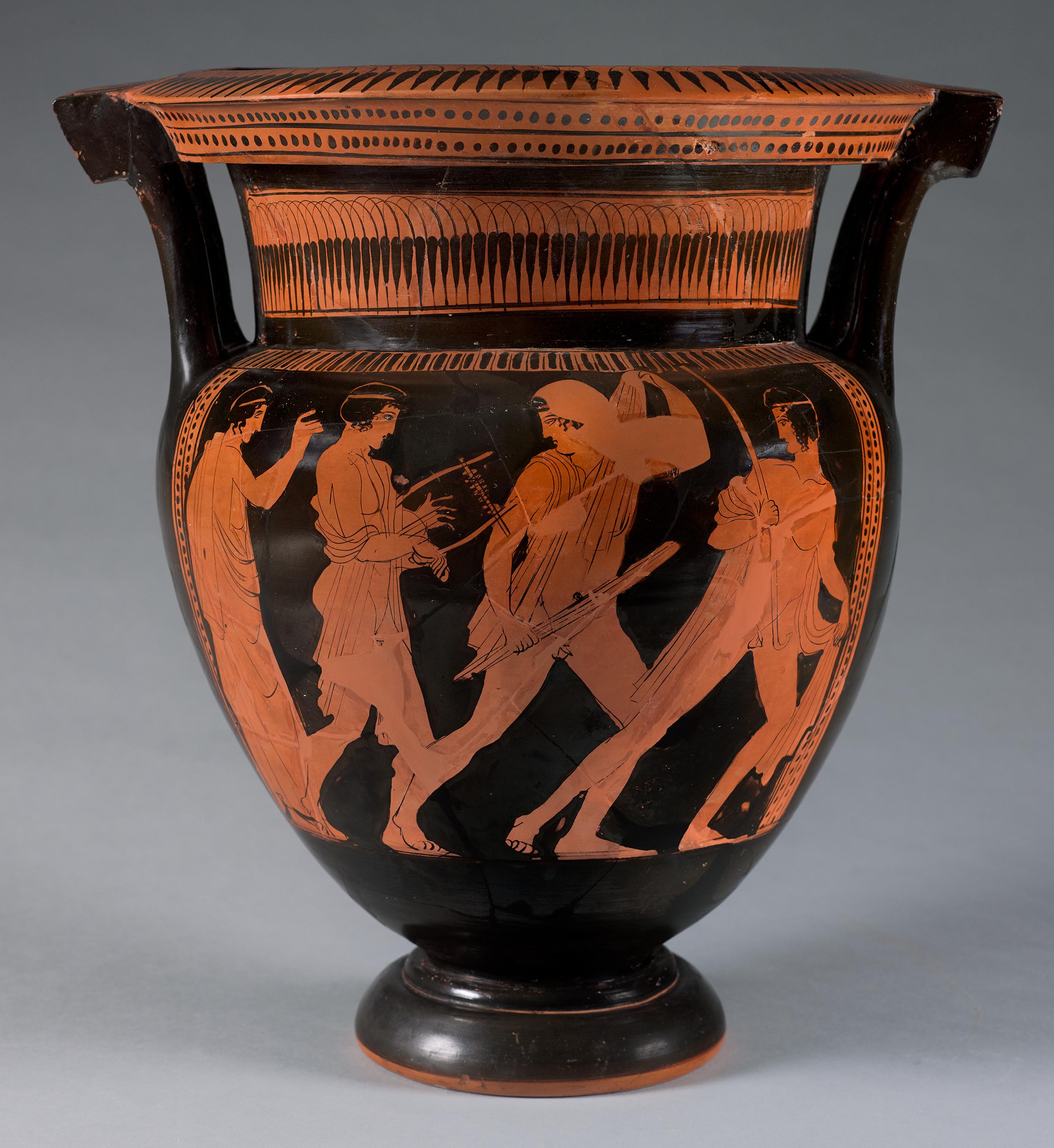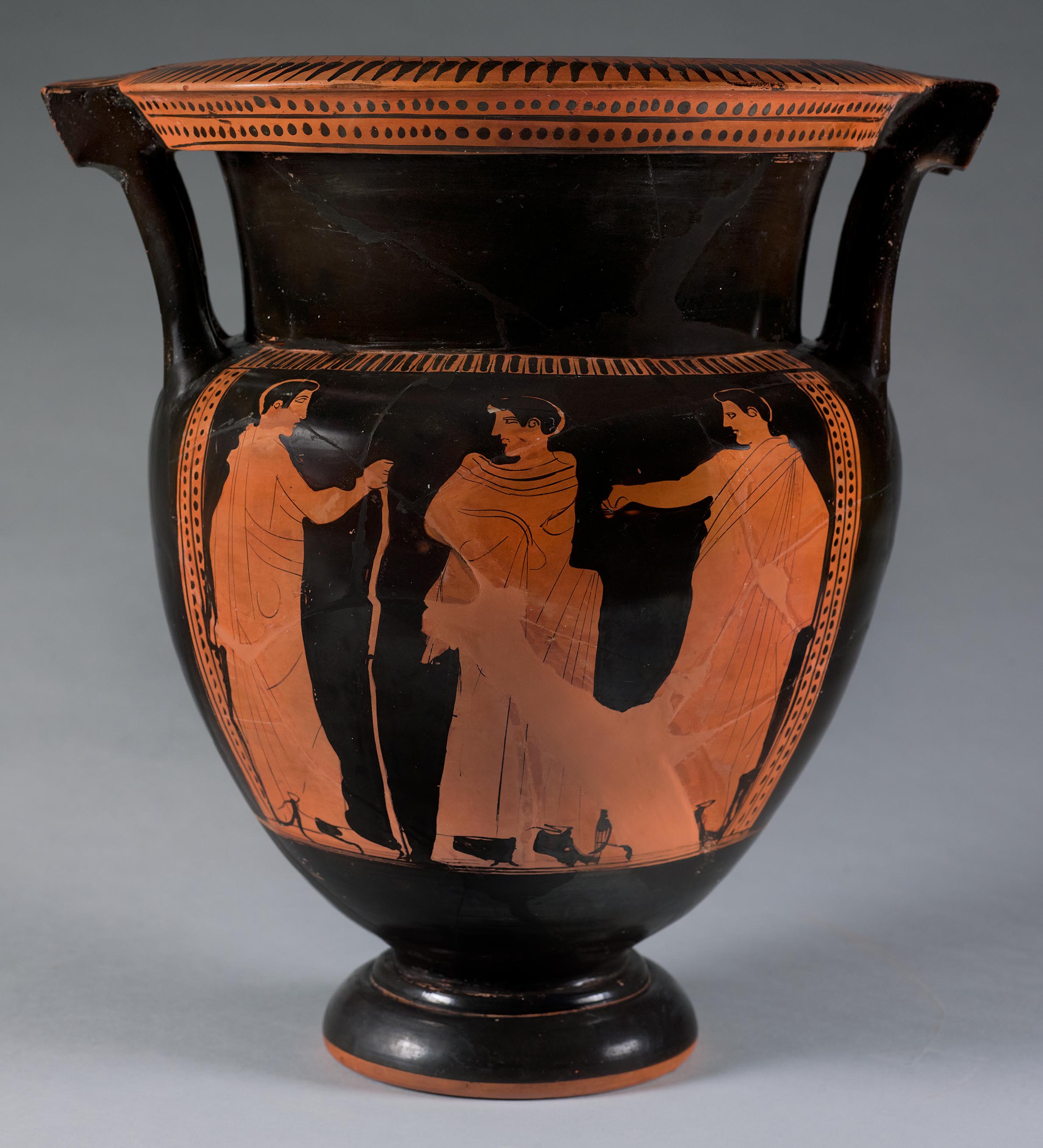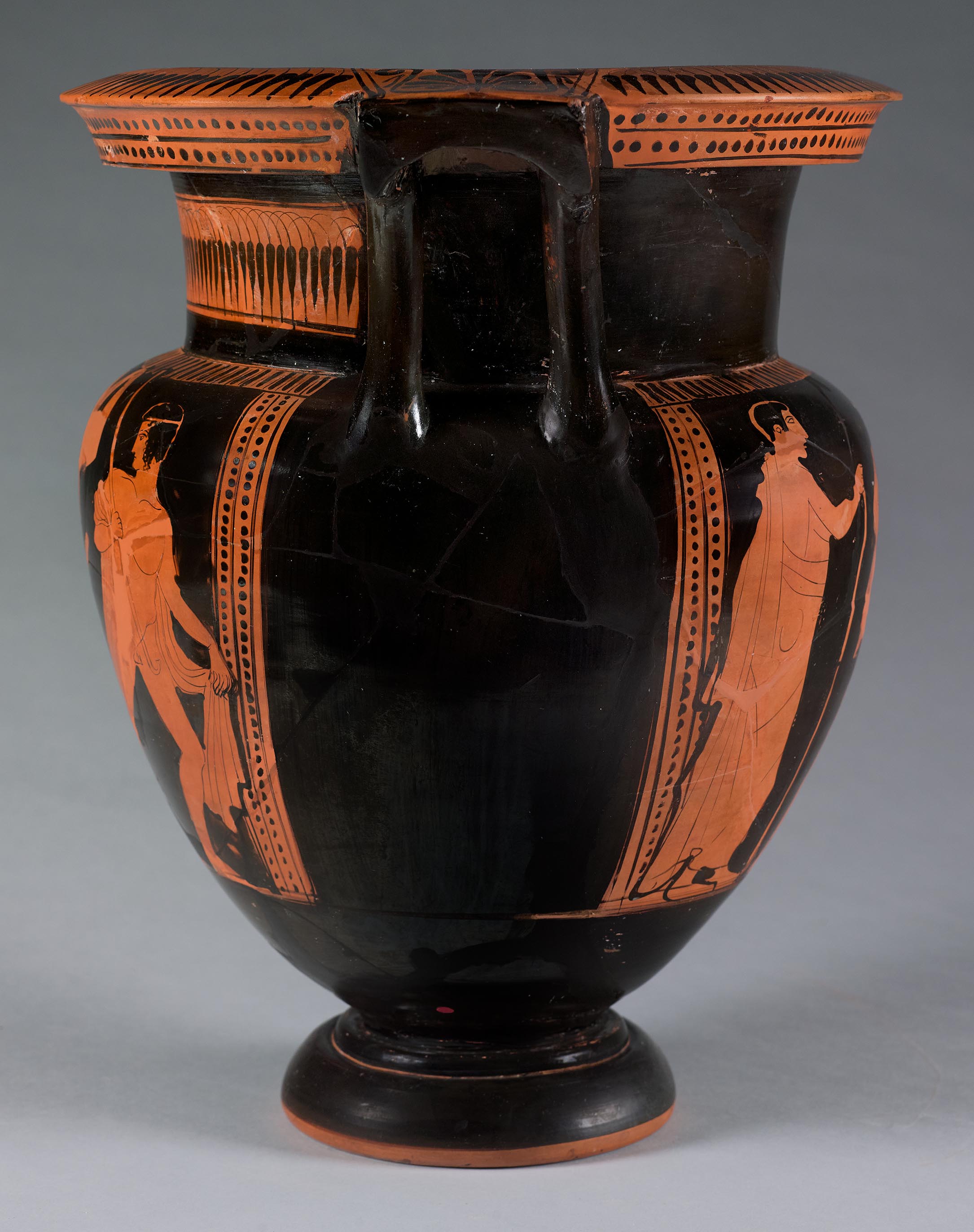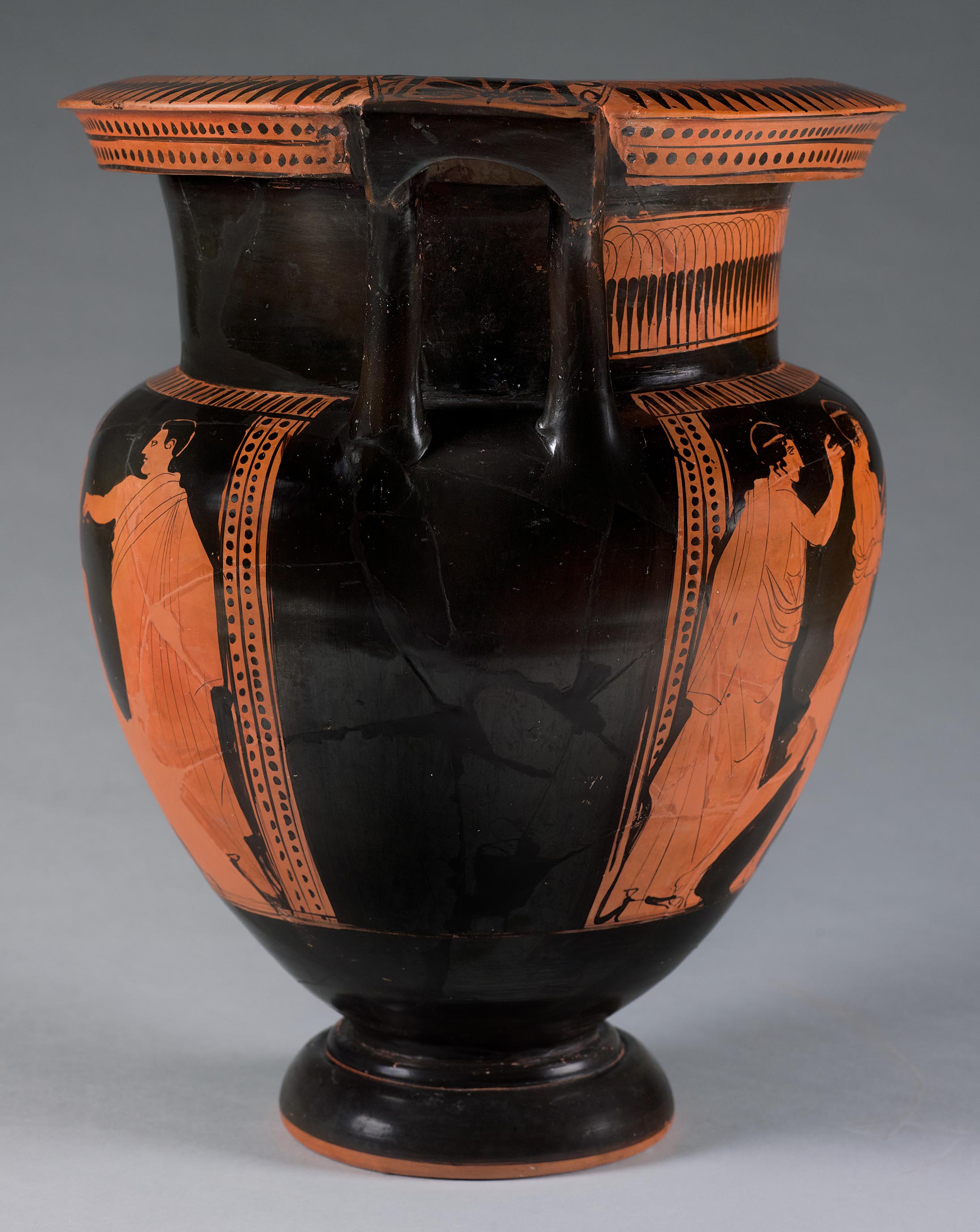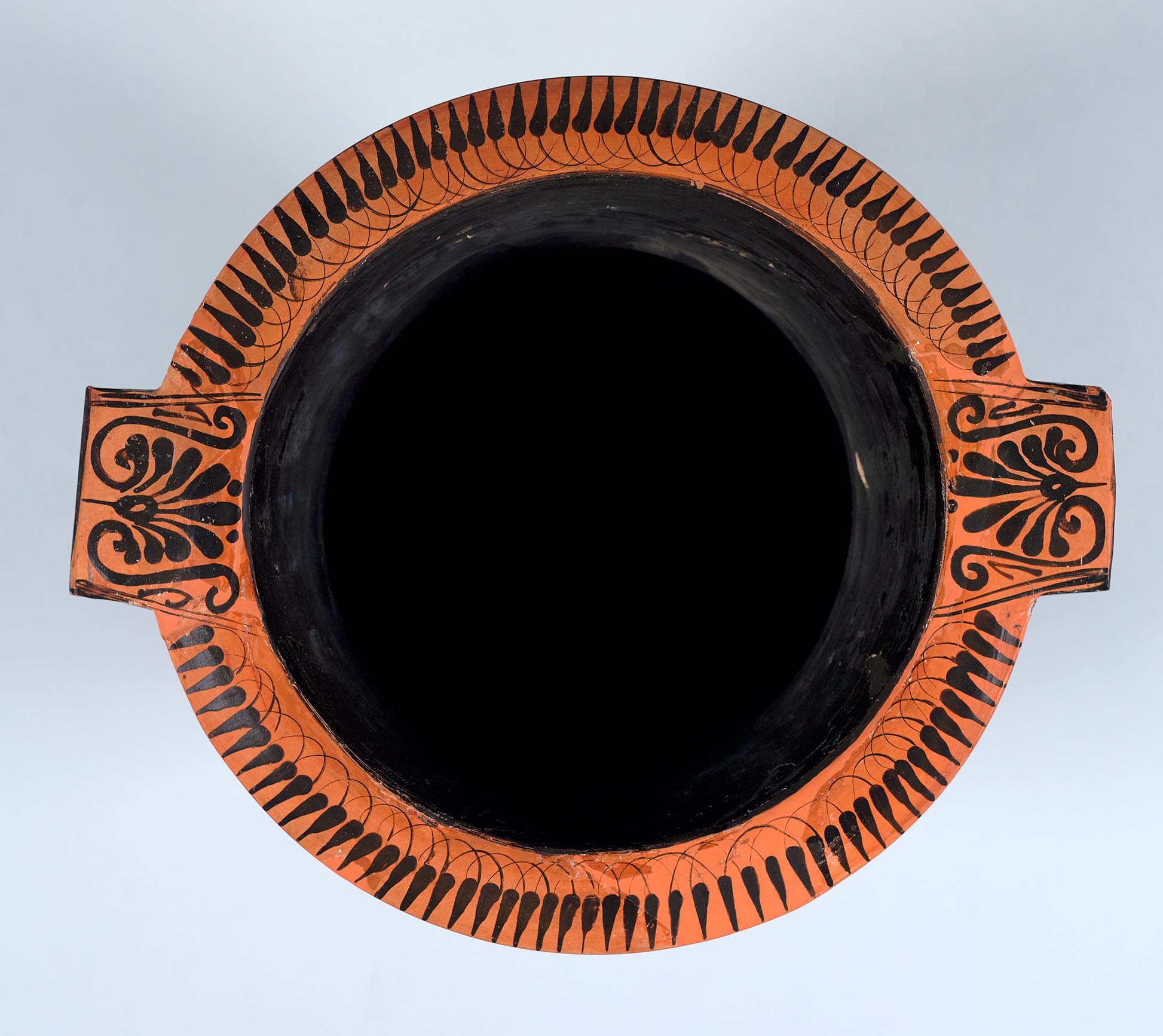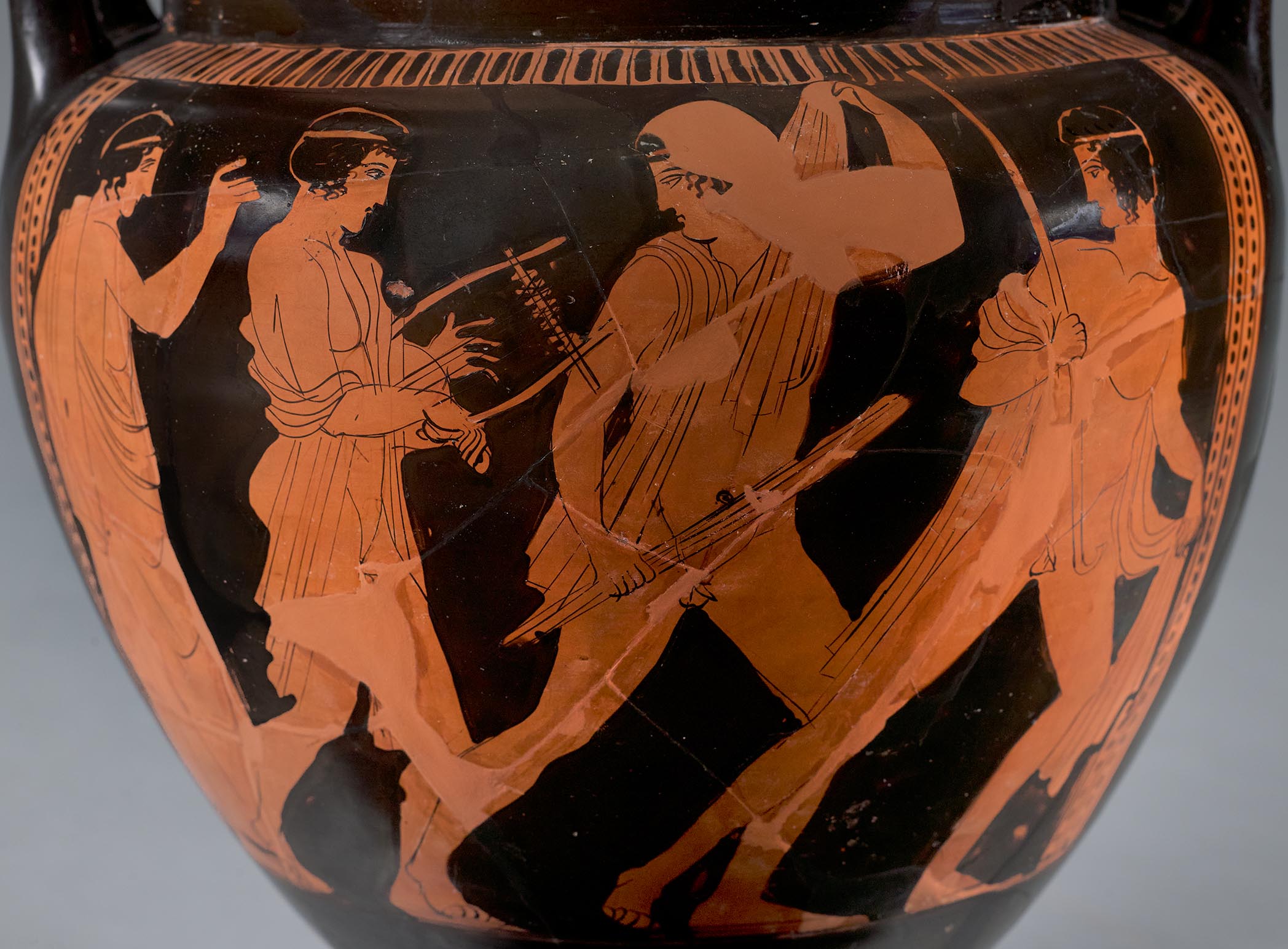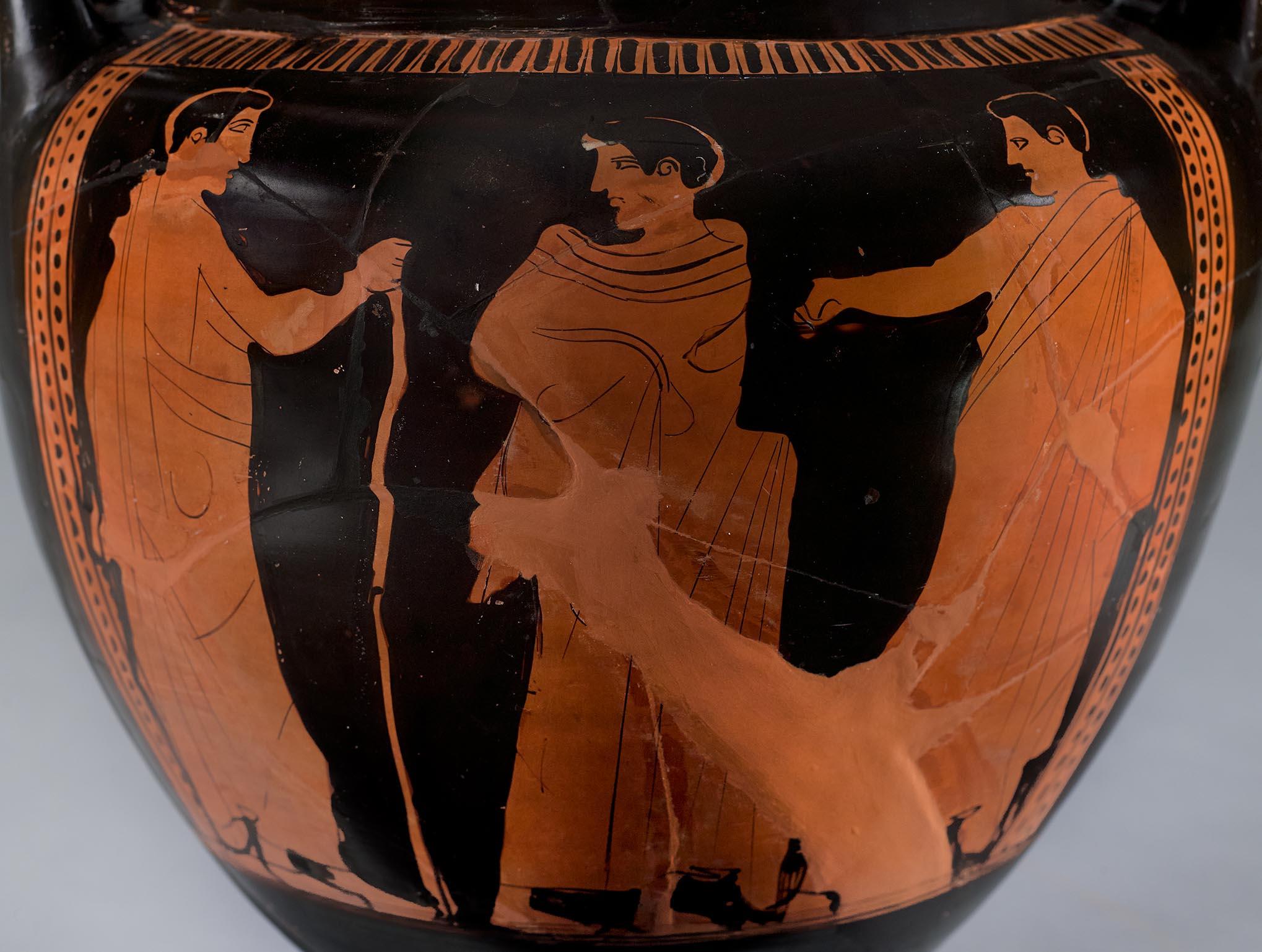Provenance
1890, gift, William Cowper Prime to Princeton University. Said to have been found at Nola.
Shape and Ornament
Top of rim convex; vertical overhang flaring outward at juncture with upper surface. Interior of rim and neck black. Chain of lotus buds on top of rim; band of degenerate “ivy” leaves on overhang, with the leaves rendered as black dots. Flat handle plate extending beyond the rim at each side, supported by two black “columns.” Black palmette on top of handle plates with small, reserved hearts and nine fronds. Frieze of pendant lotus buds on neck of side A. Ovoid body, interior painted a matte black, possibly in modern times. Figural panels on body framed above by black tongues, laterally by “ivy” vines. Slender reserved stripes for groundlines. Torus foot in two degrees; groove separating torus from upper degree; underside reserved.
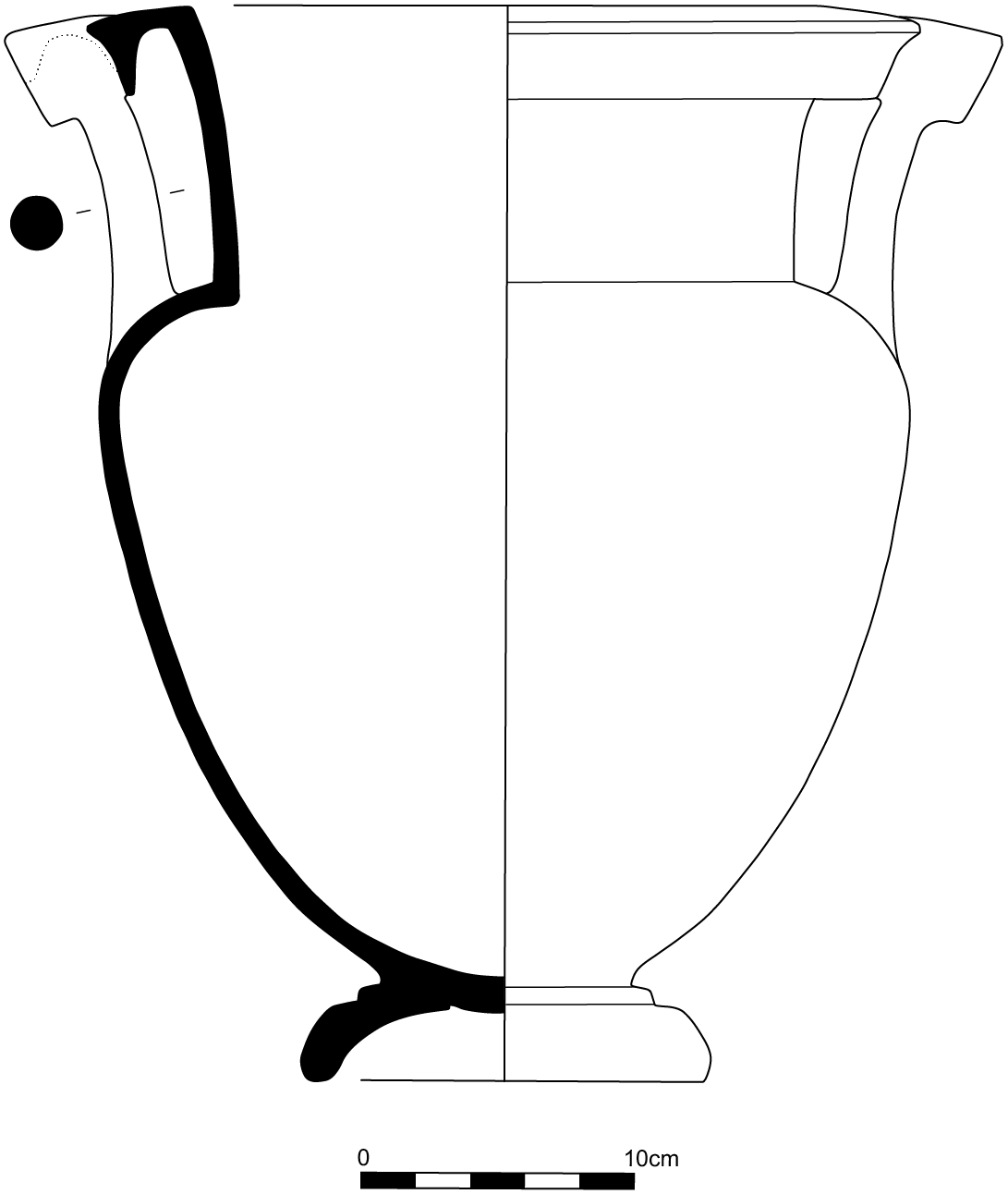
Subject
A. Komos. Four beardless youths with curly, mid-length hair participate in a drunken procession. The youth at the far left stands in profile to the right and wears a himation draped over his left shoulder, which overlaps the “ivy” border behind him. He raises his right hand, and since he is stationary and modestly dressed, his gesture suggests that he may be bidding the other three youths farewell. These three walk to the right with short mantles draped across their shoulders, exposing most of their bodies, including their loins. The first of the three, his head in profile to the right, plays a lyra (lyre), holding the plektron in his right hand and fingering the relief-line strings with his left. The next youth holds an unlit torch in his right hand and turns his head back to look at the figures behind him, his torso frontal. It is unclear from his dreamy expression whether he is gazing at the lyre player or the youth at the far left. With his right hand he plucks his mantle above his left shoulder, impinging on the tongue pattern above. The fourth figure, at the far right, also turns back to face his companions, his torso frontal. His right leg is shown nearly frontal, including his foreshortened foot and toes. The staff in his right hand breaks into the tongue pattern above. He lifts his mantle in his lowered left hand, crowding the ivy frame at right. All four youths wear garlands in their hair, executed with a reserved stripe, like a fillet, but with the addition of a series of white leaves added in short diagonal strokes, now worn.
B. Three beardless mantle figures. The youth at the left stands in profile to the right, clutching in his right hand a staff that rests on the ground. His mouth is slightly open, suggesting that he is speaking to the youth in the center, who, although moving to the right, turns his head back in response. This central youth is completely wrapped in his himation, with his arms gesturing beneath the mantle. Slightly shorter than the two other figures, he may be a younger boy whom they are accosting. The youth at the right faces the boy and extends his right arm toward him. All three figures wear fillets in added white, now worn.
Attribution and Date
Attributed to the Ariana Painter [following J. D. Beazley, “perhaps”]. Circa 460 BCE.
Dimensions and Condition
h. 39.4 cm; w. 36.8 cm; diam. of mouth 31.5 cm; diam. of foot 15.0 cm. Broken and mended, with missing pieces restored in plaster, the painting of which is now largely effaced. Significant losses to the figural decoration on side A are mainly limited to the back of the head, shoulder, and arm of the figure carrying a torch; and the right hip of the youth at the far right. On side B, filing of the edges of one large fragment has damaged the lower bodies of the two figures at right. Similar filing elsewhere on the vase has damaged the gloss adjacent to the cracks.
Technical Features
Preliminary sketch. Relief line contours used for faces and occasional flesh contours on side A; absent on side B. Accessory color. White: leaves in the garlands on side A; fillets on side B. The torch was originally longer at its right end, as indicated by the overpainting of the relief lines and eighth-inch band.
Bibliography
Abbreviation: ARV2J. D. Beazley. Attic Red-Figure Vase-Painters. 2nd ed. Oxford, 1963 1101.2; Abbreviation: BAPDBeazley Archive Pottery Database. http://www.beazley.ox.ac.uk 216144.
Comparanda
For the Ariana Painter, see Abbreviation: ARV2J. D. Beazley. Attic Red-Figure Vase-Painters. 2nd ed. Oxford, 1963 1100–1101, 1683; Abbreviation: ParalipomenaJ. D. Beazley. Paralipomena: Additions to Attic Black-Figure Vase-Painters and to Attic Red-Figure Vase-Painters. Oxford, 1971 451; Abbreviation: BAdd2Carpenter, T. H., ed. 1989. Beazley Addenda: Additional References to ABV, ARV2, and Paralipomena. 2nd ed. Oxford: Published for the British Academy by Oxford University Press. 329. Beazley said the Princeton krater was “perhaps” by the Ariana Painter, and there are ample grounds to support an attribution to his hand. On multiple occasions, the painter depicted komoi similar in detail to those on Princeton’s krater: cf., inter alia, Paris, Louvre G 351 (Abbreviation: ARV2J. D. Beazley. Attic Red-Figure Vase-Painters. 2nd ed. Oxford, 1963 1101.7; Abbreviation: BAPDBeazley Archive Pottery Database. http://www.beazley.ox.ac.uk 216140), in particular the gesturing figure at the far left. The Ariana Painter’s figures move energetically, with wide steps and animated gestures: cf. the striding komasts with Zeus and Ganymede on Paris, Cab. Méd. 416 (Abbreviation: ARV2J. D. Beazley. Attic Red-Figure Vase-Painters. 2nd ed. Oxford, 1963 1101.8; Abbreviation: BAPDBeazley Archive Pottery Database. http://www.beazley.ox.ac.uk 216141). For the drawing of hair, eyes, wreaths, and nude male anatomy, cf. the symposiasts on Würzburg 528 (Abbreviation: ARV2J. D. Beazley. Attic Red-Figure Vase-Painters. 2nd ed. Oxford, 1963 1101.5; Abbreviation: BAPDBeazley Archive Pottery Database. http://www.beazley.ox.ac.uk 216138); and on a column-krater now in a California private collection, attributed by J. M. Padgett to the Ariana Painter (Sotheby’s, Antiquities, auc. cat., July 10–11, 1989, London, lot 217). The profile eyes of his figures are particularly similar, consisting of an open triangle with two lines for the upper contour, and a vertical line for the pupil, either pendant or extending fully between the two contours of the eye. Cf. also the collarbones and lower contours of the pectorals of the symposiasts on the privately owned krater in California (supra) with the rightmost komast on Princeton’s krater.
Of the Ariana Painter Beazley (Abbreviation: ARV2J. D. Beazley. Attic Red-Figure Vase-Painters. 2nd ed. Oxford, 1963 1100) said, “These vases are very close to the Naples Painter; and I might have classed them as his—later work—were it not that they do not seem to connect with what on other grounds I take to be late work of his.” Thus, cf. the same anatomical features noted above with a komos on a column-krater that Guy attributes to the late Naples Painter: Würzburg K 1815 (E. Simon, Die Sammlung Kiseleff im Martin-von-Wagner-Museum der Universität Würzburg 2: Minoische und griechische Antiken [Würzburg, 1989], no. 142, pls. 59–60; Abbreviation: BAPDBeazley Archive Pottery Database. http://www.beazley.ox.ac.uk 46141). Cf. also, by the Naples Painter, Bochum S 512 (Abbreviation: ParalipomenaJ. D. Beazley. Paralipomena: Additions to Attic Black-Figure Vase-Painters and to Attic Red-Figure Vase-Painters. Oxford, 1971 450.55 bis; Abbreviation: BAPDBeazley Archive Pottery Database. http://www.beazley.ox.ac.uk 276107); Bologna 205 (Abbreviation: ARV2J. D. Beazley. Attic Red-Figure Vase-Painters. 2nd ed. Oxford, 1963 1101.1; Abbreviation: BAPDBeazley Archive Pottery Database. http://www.beazley.ox.ac.uk 216145). The Naples Painter’s noses often have an additional hooking line for the nostrils and are longer than the Ariana Painter’s. Note the Naples Painter’s care in delineating the abdominal muscles of his figures, details on which the Ariana Painter often does not focus, such as on Princeton’s krater.
On the reverse of his pots, the Ariana Painter typically painted three figures, either three youths or two youths and a boy. The age difference of the boy may be marked by slightly shorter stature, or, as on the Princeton krater, by fully and tightly wrapped drapery; cf. the pose and mantled arms of the third figure from the right on Würzburg 528 (supra). Closely similar figures occur on works by the Naples Painter: e.g., Würzburg K 1815 (supra). The Naples Painter’s figures are more carefully drawn, however, with loose curls of hair and clearly drawn fingers and eyes, the latter of which the Ariana Painter often drew rather cursorily, as on Princeton’s krater and Würzburg 528. For the poses and pointed chins of the two older youths on the reverse of the Princeton krater, cf. Berkeley 8/6685 (Abbreviation: ARV2J. D. Beazley. Attic Red-Figure Vase-Painters. 2nd ed. Oxford, 1963 1101.4; Abbreviation: BAPDBeazley Archive Pottery Database. http://www.beazley.ox.ac.uk 216137). Note the drapery on the figures at left on both Princeton’s and Berkeley’s kraters, in particular the U-shaped fold by the hip.
The shape is common for column-kraters painted by the Ariana Painter, in particular the high placement of the groove on the foot: cf., inter alia, Geneva 14990 (Abbreviation: ARV2J. D. Beazley. Attic Red-Figure Vase-Painters. 2nd ed. Oxford, 1963 1101.2; Abbreviation: BAPDBeazley Archive Pottery Database. http://www.beazley.ox.ac.uk 216135); Paris, Louvre G 351 (supra). These column-kraters also have nearly identical ornament, including the relatively uncommon lack of base rays and the closely spaced buds in the bud frieze on the neck. The absence of base rays and the high placement of the groove also occur on column-kraters painted by the Naples and Florence Painters: cf., by the Naples Painter, Vienna 871 (Abbreviation: ARV2J. D. Beazley. Attic Red-Figure Vase-Painters. 2nd ed. Oxford, 1963 1096.3; Abbreviation: BAPDBeazley Archive Pottery Database. http://www.beazley.ox.ac.uk 216065); by the Florence Painter, Ferrara 2688 (Abbreviation: ARV2J. D. Beazley. Attic Red-Figure Vase-Painters. 2nd ed. Oxford, 1963 541.3; Abbreviation: BAPDBeazley Archive Pottery Database. http://www.beazley.ox.ac.uk 206130). These features set the Ariana Painter’s column-kraters apart from the contemporary kraters of the Late Mannerists, the main producers of the shape at this time: cf., inter alia, Princeton y1929-203 (Entry 16). The feet of Mannerist column-kraters normally have a low groove separating the torus lower degree from a large, nearly vertical upper degree, as opposed to the Ariana Painter’s high placement of the groove on the foot.
For red-figure komoi, see C. Bron, “Le lieu du comos,” in Proceedings of the 3rd Symposium on Ancient Greek and Related Pottery: Copenhagen August 31–September 4, 1987, eds. J. Christiansen and T. Melander (Copenhagen, 1988), 71–79; B. Gossel-Raeck, “Komos: Bürger ziehen durch die Nacht,” in Abbreviation: Kunst der SchaleKunst der Schale, Kultur des Trinkens: Ausstellung der attischen Kleinmeisterschalen des 6. Jahrhunderts v. Chr. Edited by K. Vierneisel, B. Kaeser, and B. Fellmann. Munich, 1990, 293–98; T. J. Smith, “Guess Who’s Coming to Dinner? Red-Figure Komasts and the Performance Culture of Athens,” in Abbreviation: Athenian Potters and PaintersAthenian Potters and Painters: The Conference Proceedings. 3 vols. Vol. 1, edited by J. H. Oakley, W. D. E. Coulson, and O. Palagia. Oxbow Monograph 67. Vol. 2, edited by J. H. Oakley and O. Palagia. Vol. 3, edited by J. H. Oakley. Oxford, 1997 (vol. 1), 2009 (vol. 2), 2014 (vol. 3), vol. 3, 231–41. For a literary approach to the komos in Classical Athens, with reference to red-figure iconography, see B. Pütz, The Symposium and Komos in Aristophanes (Oxford, 2007).
Figures dressed in himatia appear frequently on the backs of kraters from the middle of the fifth century on, with little particularity in setting or narrative. They appear, as here, to be generic scenes of conversation. For the iconography of red-figure mantle figures, see M. Langner, “Mantle-Figures and the Athenization of Late Classical Imagery,” in Red-Figure Pottery in Its Ancient Setting: Acts of the International Colloquium Held at the National Museum of Denmark in Copenhagen, November 5–6, 2009, eds. S. Schierup and B. B. Rasmussen (Aarhus, 2012), 11–20; M. Franceschini, “Mantle Figures and Visual Perception in Attic Red-Figure Vase Painting,” Visual Past 3 (2016): 163–98.
